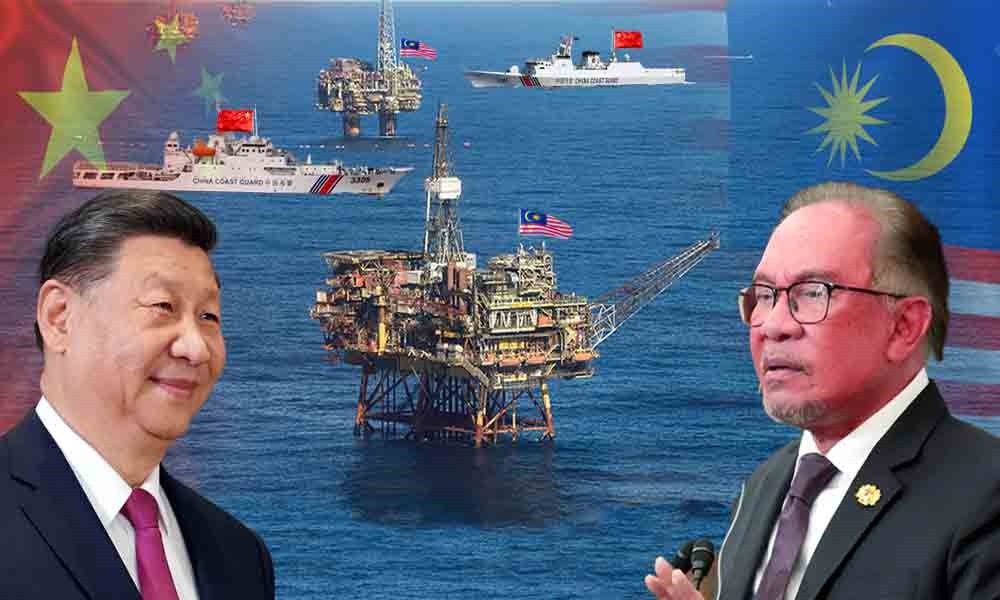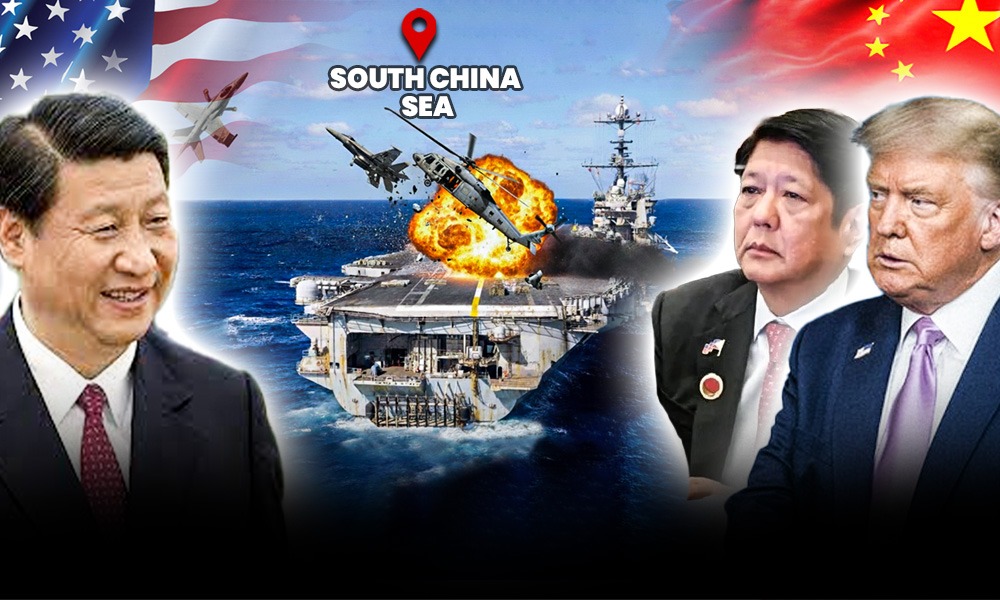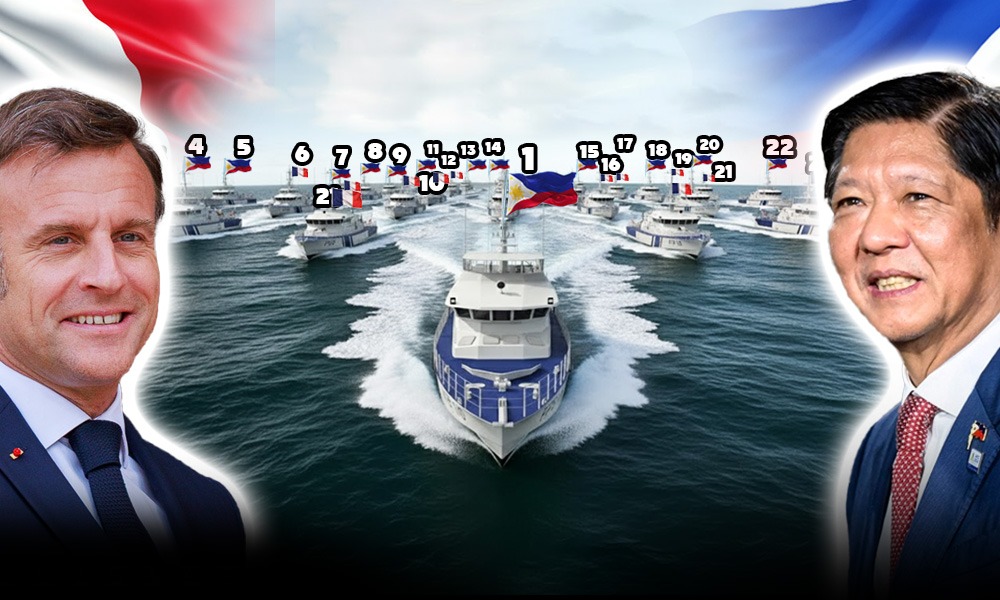Malaysia is intensifying its oil and gas exploration in the South China Sea, undeterred by the persistent presence of Chinese coast guard vessels operating near contested waters, according to a recent report by the Asia Maritime Transparency Initiative. Coastal tracking data reveal that Chinese vessel patrol Malaysia’s exclusive economic zone (EEZ) near Luconia Shoals almost daily, a critical area northwest of Sarawak State with significant Malaysian energy projects.
Malaysia’s Prime Minister Anwar Ibrahim has reiterated that state energy firm Petronas will continue oil and gas exploration in Malaysia’s exclusive economic zone (EEZ) in the South China Sea, despite persistent objections from China. Despite Beijing’s pressure, including a leaked diplomatic note urging Malaysia to halt these activities, Prime Minister Anwar Ibrahim has reaffirmed Malaysia’s right to operate in its waters, emphasizing the need to secure economic benefits while maintaining diplomatic ties with China. The report highlights China’s broader strategy of using coast guard and maritime militia fleets to assert claims over resource-rich areas, raising concerns that escalating Malaysian drilling and potential easing of China-Philippines tensions could lead Beijing to intensify its focus on Malaysian hydrocarbon production.
However, tensions persist as Chinese Coast Guard vessels frequently patrol near Malaysian offshore projects, including the Kasawari gas platform. Anwar’s approach—balancing exploration with dialogue and avoiding public confrontation over Chinese incursions—has drawn domestic criticism, with opponents accusing his administration of being too conciliatory. As Malaysia’s nearshore oil and gas reserves deplete, forcing ventures further into disputed waters, the challenge of balancing resource security with regional diplomacy grows increasingly acute.
The untapped oil and gas reserves in the Spratlys are too valuable to abandon, with billions of dollars in potential revenue at stake.
As Malaysia drills deeper and China patrols closer, the question lingers—how far will Beijing go to enforce its dominance? Will Malaysia’s pursuit of energy independence spark a dangerous standoff, or can diplomacy navigate these stormy waters before tensions boil over? Will China Allow Malaysia to Explore Oil and Gas from the Spratly islands?
Spratly Islands: Oil, Gas, and a Brewing Storm—Will China Let Malaysia Drill?
The Spratly Islands, a scattered chain of reefs, atolls, and islets in the South China Sea, have become a flashpoint—not just for their strategic location but for the immense natural wealth they conceal beneath their waters. Rich in untapped reserves of oil and natural gas, the islands have drawn interest from regional players, particularly Malaysia, which has ramped up efforts to explore and extract resources within its Exclusive Economic Zone (EEZ). But there’s a powerful obstacle: China.
Why the Spratly Islands Matter
The Spratly Islands are more than a collection of remote landforms—they sit atop vast hydrocarbon reserves that could transform the energy landscape of Southeast Asia. While estimates vary, the U.S. Energy Information Administration (EIA) has suggested the South China Sea could hold up to 11 billion barrels of oil and 190 trillion cubic feet of natural gas, with the Spratly region accounting for a significant portion.
Beyond resources, the region is critical for global trade. Roughly $3.37 trillion worth of goods, nearly a third of global maritime trade, flows through the South China Sea annually, making the area a vital economic artery. Control over these waters means control over energy security and trade routes, amplifying the stakes for regional dominance.
The Core Conflict: Sovereignty vs. Expansionism
At the heart of the tension lies a clash between sovereign rights and expansionist claims. Malaysia, as a signatory of the United Nations Convention on the Law of the Sea (UNCLOS), holds the legal right to explore and extract resources within its 200-nautical-mile EEZ. Parts of the Spratly Islands fall squarely within this zone, giving Malaysia a legal basis for its energy projects.
China contests this through its expansive “New Ten-Dash Line” claim, which covers nearly 90% of the South China Sea, including waters far beyond the internationally recognized EEZ boundaries of Malaysia, Vietnam, and the Philippines. This sweeping claim, despite being ruled invalid in The Hague’s 2016 arbitral tribunal decision, continues to shape China’s aggressive behavior in the region.
Malaysia’s Push for Energy Independence
Facing rising energy demands and the need for economic growth, Malaysia has increasingly prioritized offshore drilling projects. The Kasawari Gas Field, located near the Spratlys, is a prime example of Malaysia asserting its resource rights. Malaysia’s state-owned energy giant Petronas has continued exploration despite mounting Chinese resistance.
Recent reports have shown Chinese maritime militia vessels and coast guard ships shadowing Malaysian exploration vessels in the area, attempting to disrupt operations without direct conflict. These tactics align with Beijing’s strategy of “gray-zone warfare” actions that stop short of full-scale conflict but undermine a rival’s resource claims.
China’s Reluctance to Yield Control
China’s interest in the Spratly Islands extends far beyond oil and gas. The islands hold strategic military value, with China building artificial islands and heavily militarizing them with airstrips, missile systems, and naval facilities. The Fiery Cross Reef and Subi Reef have been transformed into military outposts capable of projecting power across the entire South China Sea.
By controlling the Spratlys, Beijing strengthens its anti-access/area denial (A2/AD) strategy, deterring external military intervention while asserting dominance over regional trade and resources. Yielding to Malaysia’s drilling would not only undermine this posture but also encourage other Southeast Asian nations to challenge China’s claims.
A Tense Future: Conflict or Cooperation?
Despite Malaysia’s legal standing, China is unlikely to fully acquiesce to its oil and gas activities in the Spratly Islands. The growing presence of Chinese vessels and the use of “cabbage strategy” tactics—surrounding contested areas with multiple layers of maritime assets—suggest Beijing’s commitment to enforcing its claims through intimidation rather than open conflict.
Malaysia’s Bold Oil Play in the South China Sea: Testing China’s Patience?
Malaysia’s Prime Minister Anwar Ibrahim has taken a firm stance against China’s persistent maritime claims, reaffirming that state energy giant Petronas will continue its oil and gas exploration activities in the South China Sea, despite repeated Chinese objections.
Speaking to Parliament, Anwar declared, “We will not back down from our claims. That is why the exploration by Petronas continues, even though objections have been raised by China.” However, he added a note of diplomacy, emphasizing that Malaysia remains open to dialogue, aligning with ASEAN’s principle of centrality that prioritizes dispute resolution through peaceful discussions.
Anwar’s Balancing Act: Diplomacy or Defensiveness?
Anwar’s approach has sparked domestic debate. While affirming Malaysia’s sovereign rights, he has avoided direct confrontation with Beijing, opting for a more discreet diplomatic path—unlike the Philippines’ assertive transparency campaign, which publicly exposes Chinese maritime incursions.
Critics, including Malaysia’s political opposition, argue that Anwar’s diplomatic tone risks projecting weakness. The pressure mounted in August 2024, when a leaked Chinese diplomatic note revealed Beijing’s demand for Malaysia to halt all offshore exploration, including the Kasawari Gas Field operations. This forced Anwar to clarify Malaysia’s stance, asserting in Vladivostok that Malaysia had every right to “secure economic advantage, including drilling for oil in our territory.”
The Coming Tipping Point?
Malaysia’s offshore energy reserves closer to its shores are dwindling, making continued exploration in contested waters increasingly critical for national energy security. The question remains: How long can Malaysia balance economic ambitions with Chinese assertiveness?
As Anwar juggles diplomacy with defiance, the risk of a larger confrontation looms. For now, Malaysia’s strategy involves a silent resistance—but with China’s maritime presence showing no signs of retreat, the clock on a peaceful resolution may be ticking faster than expected.
“Peaceful Rise” vs. Assertiveness
China’s actions in the South China Sea reveal a stark contradiction between its proclaimed policy of a “peaceful rise” and its increasingly assertive behavior in regional disputes.
Peaceful Rise Narrative: Since the early 2000s, China has emphasized its rise as a major power that does not seek hegemony or territorial expansion. This narrative aimed to reassure neighboring countries and global powers that China’s growth would be cooperative and beneficial.
Contradictory Actions: Despite this rhetoric, China’s behavior in the South China Sea, including militarization of artificial islands and aggressive patrolling, undermines the peaceful rise narrative. The construction of runways, missile systems, and radar facilities on reclaimed reefs directly contradicts the promises of non-militarization made by President Xi Jinping during bilateral talks with the U.S.
Strategic Ambiguity: China’s strategy seems focused on expanding its control incrementally while avoiding open conflict. This dual approach allows China to maintain economic cooperation with ASEAN nations while simultaneously strengthening its strategic foothold. China’s assertive actions in the South China Sea challenge its own diplomatic narratives and continue to destabilize regional security.
Prospects for Cooperation and Conflict between China and Malaysia in the South China Sea
Potential for Cooperation
Despite ongoing tensions, there remain avenues for cooperation between China and Malaysia in the South China Sea. One significant area is joint hydrocarbon development. Both nations could benefit from shared exploration and production ventures, minimizing disputes while maximizing economic gains. Establishing cooperative fisheries agreements could help manage shared maritime resources sustainably, reducing overfishing while fostering diplomatic dialogue. China and Malaysia could also collaborate on maritime security initiatives, such as joint search-and-rescue operations and combating piracy, fostering mutual trust.
Risks of Conflict
The risks of conflict remain significant due to China’s assertive actions and Malaysia’s continued resource exploration. Accidental clashes, such as unintentional collisions between Chinese coast guard vessels and Malaysian exploration ships, could escalate tensions rapidly. Miscalculations, particularly if either side perceives aggressive maritime movements as provocations, could further heighten the risk of confrontation. The continuous presence of Chinese maritime militia and coast guard vessels near Malaysia’s EEZ raises the possibility of standoffs that could spiral into armed conflict if not carefully managed.
Role of International Law and Regional Mechanisms
International law, particularly the United Nations Convention on the Law of the Sea (UNCLOS), plays a crucial role in defining maritime entitlements and EEZ boundaries. The 2016 arbitral tribunal ruling, which invalidated China’s expansive nine-dash line claims, sets a legal precedent favoring Malaysia’s position. However, China’s refusal to recognize the ruling limits its enforcement.
Regional organizations such as ASEAN have the potential to mediate tensions through mechanisms like the Code of Conduct (COC) negotiations for the South China Sea. ASEAN’s consensus-based decision-making process often hampers decisive action. Major powers like the United States also play a role in promoting freedom of navigation and balancing China’s assertiveness through military patrols and diplomatic support for Southeast Asian claimants. Balancing cooperation and conflict management will require sustained diplomatic efforts, adherence to international legal norms, and the active involvement of regional stakeholders to ensure long-term peace and stability in the South China Sea.
Historical Context of Chinese Claims
China’s claims over the South China Sea are rooted in historical factors, with references to ancient Chinese fishing activities and maritime presence often used to justify its territorial assertions. Chinese fishermen have operated in the region for centuries, and China has used this long-standing presence as a basis for its claims of historical rights to the area. Historical maps further reinforce these claims, showcasing China’s supposed control over vast portions of the South China Sea, particularly through the concept of the “nine-dash line.”
The “nine-dash line” was first introduced by China in the 1940s and has since evolved to encompass most of the South China Sea. This territorial demarcation is claimed by China to reflect its historical rights over the waters and surrounding islands. Over the years, the nine-dash line has become central to China’s territorial dispute with several Southeast Asian nations. However, the international legal community largely rejects the validity of this claim. The 2016 South China Sea Arbitration, conducted by the Permanent Court of Arbitration, ruled that China’s claims under the nine-dash line have no legal basis under international law, particularly in relation to the United Nations Convention on the Law of the Sea (UNCLOS).
The Disputed South China Sea
The South China Sea is one of the most contested regions in the world, with multiple countries asserting overlapping territorial claims. These include China, Malaysia, the Philippines, Vietnam, Brunei, and Taiwan, all vying for control over islands, reefs, and waters rich in resources such as oil, gas, and fisheries. The disputes have been a source of tension in the region for decades, with each nation citing historical, geographical, and legal grounds for their claims.
Beyond territorial control, the South China Sea is vital for global trade and security. Over $3 trillion worth of goods pass through these waters annually, making it one of the most important maritime trade routes in the world. Ensuring freedom of navigation and overflight is essential for international shipping, as well as for regional stability and security. The importance of maintaining open access to these waters has led to international calls for resolving the disputes peacefully and ensuring that no single nation can monopolize access.
China’s increasing militarization of the South China Sea has further exacerbated tensions. Over the past decade, China has built artificial islands and established military installations on several disputed features, asserting its control over vast areas of the sea. These developments, which include airstrips, radar stations, and military bases, have been perceived as a direct challenge to the claims of other nations and a way for China to solidify its dominance in the region. This militarization has not only heightened tensions with rival claimants but has also raised concerns among the broader international community about the potential for conflict in the region.
Takeaway
China has consistently opposed Malaysia’s oil and gas exploration activities in the South China Sea, particularly in areas within Malaysia’s exclusive economic zone (EEZ) that overlap with China’s extensive territorial claims. Despite China’s objections, Malaysia has maintained its stance on continuing these exploration efforts.
In October 2024, Malaysia expanded its oil and gas exploration activities in the disputed waters of the South China Sea. A U.S. think tank reported that Chinese vessels have maintained a constant presence near Malaysia’s drilling operations, exerting pressure to halt these activities.
Prime Minister Anwar Ibrahim reiterated Malaysia’s commitment to continuing oil and gas exploration in its portion of the South China Sea, despite China’s protests. He emphasized that these operations are within Malaysia’s territorial waters and are not intended to provoke China. Anwar stated that halting these activities is not an option, although Malaysia remains open to discussions with China.
In response to Malaysia’s exploration activities, China has increased its diplomatic and maritime pressure. In September 2024, a classified diplomatic note from China to Malaysia’s embassy in Beijing was leaked, asserting that Malaysia’s oil and gas exploration activities in the South China Sea infringed on China’s sovereignty. The Malaysian government announced an internal investigation into the leak and reiterated its commitment to defending its interests while engaging in peaceful dispute resolution with China.
Additionally, Chinese patrol boats have been closely monitoring Malaysian survey vessels in the Luconia Shoals area, located within Malaysia’s EEZ. This area is rich in hydrocarbons and has been a focal point of tension between the two nations.
In conclusion, while China has consistently opposed Malaysia’s oil and gas exploration in the South China Sea, Malaysia has maintained its position on continuing these activities. The situation remains complex, with ongoing diplomatic tensions and maritime confrontations. The future of Malaysia’s exploration efforts will depend on the evolving geopolitical dynamics and the willingness of both nations to engage in dialogue and negotiation.



